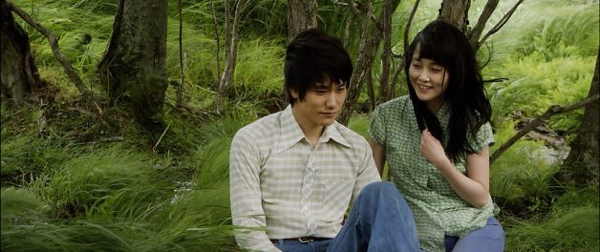Movie review by Greg Carlson
A lushly photographed and finely acted adaptation of Haruki Murakami’s 1987 novel, Anh Hung Tran’s “Norwegian Wood” labors to balance its central poles exploring sexuality and death. Embracing the most melodramatic aspects of a story tracing the late teens and early twenties of Tokyo student Toru Watanabe (Ken’ichi Matsuyama), Tran’s measured, elegiac contemplation combines the instincts of Douglas Sirk and Robert Bresson without quite capturing the former’s keen interest in and understanding of women and the latter’s ability to reveal the contours of the human soul. Grim, determined, and austere, “Norwegian Wood” succeeds in illustrating the numbing grief experienced by the living following a loved one’s suicide without attempting a clinical or logical explanation of that unthinkable circumstance.
Following a prologue that ends with the carbon monoxide poisoning death of Toru’s close friend Kizuki (Kengo Kora), Toru connects with Kizuki’s closest companion and childhood sweetheart Naoko (Rinko Kikuchi), celebrating her birthday with an intense evening culminating in the loss of Naoko’s virginity. Tran captures the thanatotic and erotic nexus of Toru and Naoko’s shared guilt, painting a moment that instinctively blends the characters’ carnal hunger for one another with their mutual impulse to be close to the memory of Kizuki. Sex does not, however, heal the gaping emotional wounds of Naoko, whose feelings of responsibility for Kizuki’s suicide lead her to a nervous breakdown and an extended stay in a mental health sanitarium.
With a sense of obligation to the memory of Kizuki, Toru promises to wait for Naoko during her exile from everyday life, but the long separation and the interest of the free-spirited and candid Midori (Kiko Mizuhara) complicate the pledge. Tran fails to adequately express Toru’s conundrum by favoring the ethereal and angelic Naoko over the sprightly and vivacious Midori, and the disparity is one of the movie’s most frustrating imbalances. Toru’s resolute silence doesn’t help, but the viewer is often frustrated by Toru’s unwillingness to open up, making it difficult to believe that a person as stimulating and expansive as Midori would put up with Toru’s moody brooding.
Tran envisions the late 1960s setting with a deliberate resistance to foreground placement of the political movements embraced by scores of young people seeking measurable social change. In one scene, Toru is carried along on a wave of street demonstrators, but the protest does not register for him; he remains self-absorbed and lost in the thoughts of his romantic crisis even as he becomes enveloped in the din. Tran introduces other markers of the era, most notably the inclusion of a trio of fantastic cuts by Can associated with Toru’s part time job in a record store, but the production and costume design evoke a timelessness that allows the film to exist independently of period.
In spite of the leisurely running time of the film, Tran’s screenplay makes substantial alterations and omissions from the novel, especially concerning the characters of Midori and Naoko’s roommate Reiko. Even so, the movie adaptation has several compelling factors that strongly recommend a viewing, including the vivid score by Johnny Greenwood and the sensational photography by Mark Lee Ping Bin, both of which surprise and impress in scene after scene. In one tour de force sequence, an elaborate back-and-forth tracking shot follows Toru and Naoko as they pace through tall, windswept grass during one of Naoko’s rare verbal confessions. If Tran does one thing exceptionally well, it is in the construction of a metaphor likening Naoko’s fragility and inner turmoil with the natural elements and the changing seasons.
